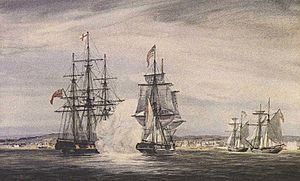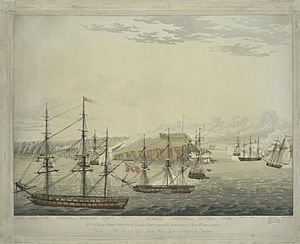HMS Royal George (1809) facts for kids

Depiction of the engagement of Royal George and the American brig Oneida in Kingston harbour
|
|
Quick facts for kids History |
|
|---|---|
| Name | HMS Royal George |
| Builder | Kingston Royal Naval Dockyard, Kingston |
| Laid down | February 1809 |
| Launched | July 1809 |
| Renamed | Niagara 22 January 1814 |
| Honours and awards |
War of 1812 |
| Fate | Sold in 1837 |
| Notes | Provincial Marine vessel |
| General characteristics | |
| Class and type | Sloop-of-war |
| Tons burthen | 330 20⁄94 (bm) |
| Length |
|
| Beam | 27 ft 7 in (8.4 m) |
| Draught | 11 ft 0 in (3.4 m) |
| Sail plan | Square-rigged corvette |
| Complement | 95 |
| Armament |
|
HMS Royal George was a British warship that sailed on Lake Ontario during the War of 1812. It was a 20-gun wooden sloop, which is a type of small warship. The ship was first part of the Provincial Marine, a local Canadian naval force, and later joined the Royal Navy.
Royal George was very important in battles on Lake Ontario. It was the main ship, or flagship, for the Provincial Marine during the First Battle of Sackett's Harbor. In 1814, the ship was renamed Niagara. After the war ended, it was used to carry goods and was sold in 1837.
Contents
Ship Design and Features
Royal George was designed by John Dennis, a master shipbuilder for the Provincial Marine. The ship was about 29.5 meters (96 feet 9 inches) long on its main deck. It was 8.4 meters (27 feet 7 inches) wide and could go 3.3 meters (11 feet) deep in the water.
The ship was called a "ship corvette" and was square-rigged. This means it had square sails on its masts.
Ship's Armament
When it was first built, Royal George had twenty 32-pounder carronades. These were short, powerful cannons. Over time, its weapons changed.
- In early 1813, it got two 9-pounder guns.
- Later that year, it received two 68-pounder carronades and 18-pounder guns.
- By 1814, it had eighteen 32-pounder carronades, two 18-pounder guns, and one 24-pounder gun.
- By 1815, its final setup was eight 24-pounder guns, two 12-pounder guns, and ten 24-pounder carronades.
The ship usually had a crew of 95 sailors, but this number grew to 175 by 1830.
Service History
In 1808, the British found out that the United States was building a warship called Oneida. To match this, the British decided to build Royal George. Its construction started in February 1809 at the Kingston Royal Naval Dockyard in Kingston, Ontario. The ship was launched in July 1809.
Royal George wasn't used right away. It waited until 1811, after the Americans lifted a trade ban on Great Britain. The ship only began active service when the Americans started getting ready for war. In 1811, Major General Isaac Brock inspected the Provincial Marine. Lieutenant Hugh Earl was put in charge of Royal George, making it the flagship of the Provincial Marine.
Early War of 1812 Actions
The War of 1812 started in July 1812. At the beginning, the British fleet on Lake Ontario was stronger than the American one.
On 19 July, Royal George and other British ships sailed towards Sackett's Harbor, New York. They wanted to fight the American ship Oneida. Oneida sailed out but then returned to port. The British ships, including Royal George, then sailed into the bay. The wind died down, giving the Americans time to move their cannons from Oneida to shore defenses. When the British got close, the Americans fired, hitting Royal George several times. The British ships stopped their attack and left. This was known as the First Battle of Sackett's Harbor. For the rest of 1812, Royal George mostly carried soldiers and supplies for the British Army.
On 1 October, Royal George anchored near the Genesee River. A group of 80 armed men went ashore and captured an American ship called Lady Murray and a small revenue boat. This was the only successful attack by the British fleet when it was solely under the Provincial Marine's command.
The Chase of Royal George
In November 1812, Royal George was the biggest warship on Lake Ontario. On 9 November, an American fleet of seven ships, led by Commodore Isaac Chauncey, surprised Royal George near the Bay of Quinte. Royal George managed to escape by sailing into a narrow channel as night fell. It reached the safety of Kingston harbour by 2:00 AM.
The next morning, 10 November, the American fleet continued chasing. They burned a small ship and then approached Kingston. They came under fire from shore batteries. Chauncey tried to capture Royal George inside Kingston's harbour. Cannons from the shore, including two batteries on Point Henry, fired at the Americans. American cannonballs hit the town, but they couldn't capture Royal George, which moved deeper into the harbour. The Americans anchored, planning to attack again the next day. However, a storm approached, forcing Chauncey to return to his base without capturing the ship. Only one sailor was killed on Royal George, and the ship itself had only minor damage.
This was the only time the Americans attacked Kingston during the War of 1812. After this, strong defenses were built at Point Henry to protect the dockyards.
New Leadership and More Battles
During the winter of 1812–1813, Royal George became dirty and messy. In May 1813, Commander Robert Heriot Barclay took temporary command of the Lake Ontario squadron. Soon after, Captain Sir James Lucas Yeo arrived to take full command of the naval forces on the Great Lakes. Commander William Mulcaster was then given command of Royal George. Most of the crew were now from the Royal Navy.
On 27 May, Royal George was part of the British squadron that attacked Sackett's Harbor. They captured 115 American soldiers. Although Royal George didn't fight directly, the British managed to destroy the American shipyard.
On 3 June, the squadron left Kingston to resupply British forces. They spotted a large American camp and Royal George helped bombard it, forcing the Americans to retreat. The squadron then sailed along Lake Ontario's southern shore, firing at Fort Oswego and raiding Sodus. They returned to Kingston on 26 June.
The squadron returned to Lake Ontario on 31 July. On 6 August, Royal George had a leak, and its gunpowder got wet. The leak wasn't found, so sailors had to pump water constantly. On 7 August, the American squadron was spotted. The ships exchanged fire, but the Americans stayed close to their shore batteries. On 10 August, the two squadrons met again. Royal George, along with other British ships, forced two American schooners to surrender. After this, Royal George's leak was found and fixed.
On 11 September, the squadrons met again near the Genesee River. Royal George and another British ship were closest to the American line and suffered damage to their sails and rigging. Four sailors were killed and five were wounded. The British retreated, and Royal George had to tow another ship that couldn't keep up. Back in Kingston, Royal George received a new 24-pounder long gun.
On 28 September, in a battle known as the "Burlington Races", Royal George played a key role. The British flagship, Wolfe, was damaged. Mulcaster bravely placed Royal George between Wolfe and the American ship General Pike, allowing Wolfe time to make repairs. Royal George exchanged fire with General Pike, forcing it to turn away. After repairs, the squadron returned to Kingston on 7 October.
William Mulcaster was promoted and given command of a new ship. Royal George went on one last patrol on 3 December before being prepared for the winter.
Renamed Niagara and Final Years

On 22 January 1814, Royal George was renamed Niagara. It was reclassified as a sixth-rate ship, a type of warship. Captain Stephen Popham took command.
On 4 May, Niagara and the squadron sailed to attack Fort Oswego. They arrived on 5 May. The next morning, Niagara moved very close to the shore and began firing directly at the fort. Niagara caught fire three times during the battle. In the end, the British captured the fort and its supplies. The force returned to Kingston on 8 May.
On 19 May, the squadron blocked Sackett's Harbor. Captain Popham was later killed or captured by Americans at Sandy Creek. Niagara was left with a small crew, and sailors from other ships were moved to fill it up. Captain Henry Davies then took command of Niagara.
After a very large new British ship, St Lawrence, was launched on 10 September, Captain Edward Collier took command of Niagara. With St Lawrence now on Lake Ontario, the American squadron stayed in Sackett's Harbor for the rest of the war. Niagara left Kingston on 28 November, carrying cannons for ships being built at a new naval base.
On 24 December 1814, the Treaty of Ghent was signed, ending the War of 1812. After the war, Niagara was used to transport goods. It was sold in 1837.
Historical Reenactment
From 30 June to 1 July 2012, a three-day reenactment of Royal George's escape was performed. It went from Bath, Ontario, to Kingston. This event celebrated 200 years since the War of 1812. The role of Royal George was played by the brig Niagara, which is one of the last remaining tall ships from the 1812 era.
See also

